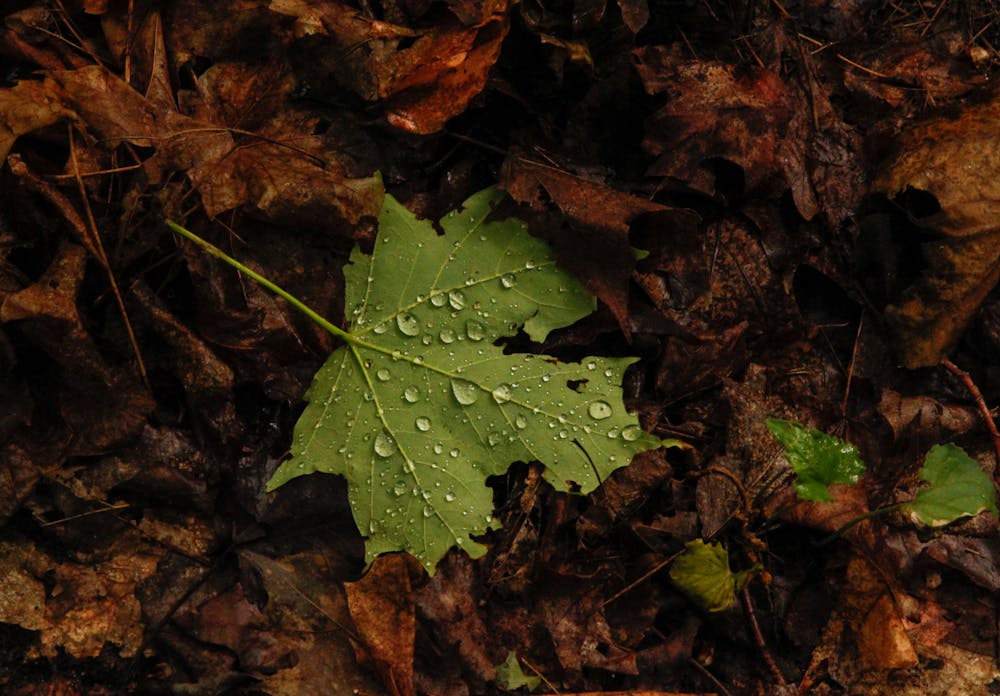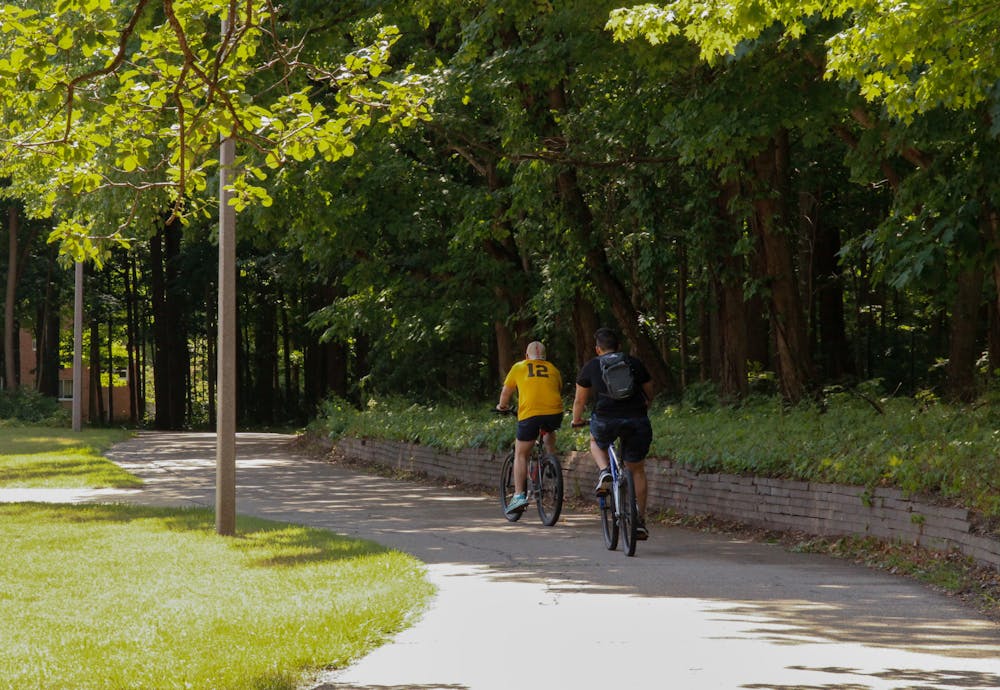“If someone is proximal to those locations, and they have 20 or 30 minutes they want to use at their lunch break to go for a walk, it’s just a nice change of venue because it’s a little more natural,” Program Consultant for MSU Moves TJ Hall said. “The traffic, the bikes and pedestrians are really cut down.”
MSU Moves is a sub-initiative of the MSU Health4U Program, which provides classes, coaching and online services in order to promote healthy lifestyles.
Sanford Natural Area, a 34-acre floodplain forest, is part of the original Michigan Agricultural College campus.
“The dominant species there is sugar maple. Sugar maple is very common,” Chairperson for Department of Forestry and Professor Richard Kobe said.
Near the west entrance, visitors can spot remnants of a sugar shack from a time when these trees were tapped for syrup.
Sanford is adjacent to a section of the Red Cedar River, which gives the forest its floodplain classification and allows common floodplain growth such as bladdernut shrubs, chinkapin oak, silver maple, cottonwood and willows to flourish.

“Certainly if you’ve been on campus, you know how things flood along the river there,” forest ecology professor David Rothstein said. “So that’s just a natural part of that ecosystem, when the river is high and overflows its banks. Those kinds of seasonally flooded parts of it are a different type of ecosystem.”
At the riverside, groups of ducks and geese gather noisily. In the winter, a makeshift hockey rink consisting of two nets and a few chairs can be spotted on the frozen surface of the river.
Throughout the forest, spray-painted logs and tree stumps serve as a place for students to sit and relax, and Sanford’s trail system makes it great for a walk to the riverside, or to serve as part of a long-distance jog.
Hall said that while the benefit of exercising on-campus versus exercising in the woods is similar, natural areas do provide advantages.
“From a physiological standpoint, oftentimes running on a trail can be a little bit lower impact on the body,” he said. “If you compare running on the pavement versus running on a trail that’s got some leaf litter, bark, woodchips, things like that. The natural setting really provides a little bit more natural cushion for the joints, the knees, the hips, the back.”
He said that he encourages those that experience pain from running to try running on a natural surface instead.
Additionally, Hall said, exercising in these areas can provide one a feeling of mindfulness that may be hard to attain on campus.
“Walking in nature opens up a new opportunity to really sort of connect with nature, observe things that maybe you hadn't noticed before, attempt to practice mindfulness,” Hall said.
The Baker Woodlot and accompanying Rachana Rajendra Neotropical Migrant Bird Sanctuary within the Woodlot is located just under two miles south of the Sanford Natural Area, on the line between MSU’s concrete campus and the sprawling fields where students study agriculture and livestock.
The woodlot is named after early Michigan foresters James Fred Baker and Harry Lee Baker, and contains trees, vegetation and wildflowers that provide food, water and shelter to migratory birds.
These neotropical migrants, including birds like the red-winged Blackbird and the Northern Cardinal, move across continental boundaries to places like Mexico, the West Indies and Central and South America.
The birds travel anywhere between a few hundred miles and thousands of miles, braving threats such as predators, storms, buildings and a lack of rest areas. Woodlots provide these birds with refuge, allowing them to rest before they begin the next leg of their journey.
Rachana Rajendra, the sanctuary’s namesake, was a resident of Okemos and a lover of birds and nature. She was killed in a car crash in 1997, and her parents, along with the help of friends and family, established an endowment in her name.
One of the functions of this endowment is to provide maps and educational materials about neotropical migrant birds in the Baker Woodlot.
“Baker Woodlot, it's really a beautiful stand of trees,” Kobe said. “It’s quite diverse, it has black cherry, red oak, American beech, sugar maple, red maple and other species in the overstory.”
There are also a few Douglas fir trees from the western U.S.

Bikers ride past the Sanford Nature Area in east campus.
—“It’s very productive … the soils are pretty good there,” Kobe said.
While there is a forest in every direction, the trees are tall and spaced out, which gives the Woodlot an open and airy feel. On a windy day, the wind rushes through the trees, causing them to twist and groan and clack together.
Like Sanford Natural Area, the trees of Baker Woodlot grew as Michigan State University did, too. Wood from Baker was harvested to heat the dorm rooms of Michigan Agricultural College, and until the 1970s, the Department of Forestry used the forest to experiment with different methods of sustainable harvesting, Kobe said.
In the northeast corner, some trees are still numbered. Kobe said that the Department of Forestry also measures trees for their growth every year, to determine how much carbon they are taking up from the atmosphere.
Now, the main purpose of Baker Woodlot is recreational and educational. Rothstein said he uses it to teach forest ecology as well as taxonomy, or identification and classification, of trees and shrubs.
Baker Woodlot is larger than Sanford, but still very walkable, Hall said. The trails are perfect for runners — repeated loops of the outside trail would make a great speed workout.
Hall said that students may also find these natural areas as a good way to supplement a workout regiment they are already accustomed to.
“Variety is really good, especially in physical activity. Any gym goer knows that if you just go for four straight months, doing the same lifts, the same regimen, the same weight, you're going to plateau,” Hall said. “Even if you've never really thought about running on a path, or in the woods or on a nature trail or anything like that, give it a try, because you might find that it's awesome.”
Whether students use these areas to sit and relax or to push their bodies physically, these natural areas are a valuable resource to any student looking for a quick escape from everyday life at MSU.
“Having some really large areas of really nice forest that are right there on campus is just unheard of. I’ve never been on a campus that has that,” Rothstein said.
This article is part of our 2021 Summer Mail Home Issue. View the full digital issue here.
Discussion
Share and discuss “Students looking to relax or get some exercise can visit campus natural areas” on social media.
"looking" - Google News
July 29, 2021 at 07:05PM
https://ift.tt/3zQORqq
Students looking to relax or get some exercise can visit campus natural areas - The State News
"looking" - Google News
https://ift.tt/2tdCiJt
Shoes Man Tutorial
Pos News Update
Meme Update
Korean Entertainment News
Japan News Update
Bagikan Berita Ini














0 Response to "Students looking to relax or get some exercise can visit campus natural areas - The State News"
Post a Comment